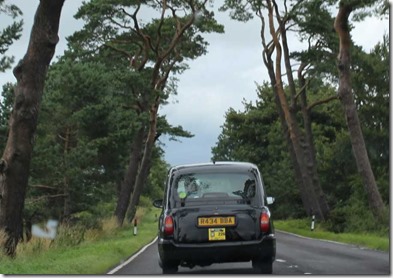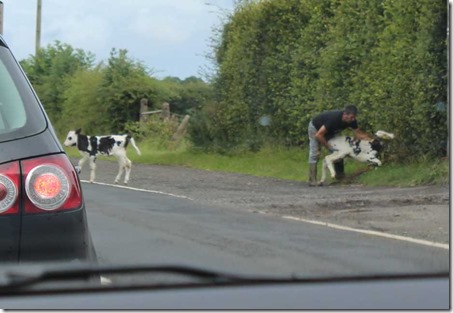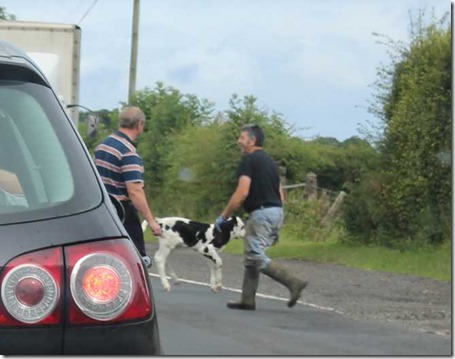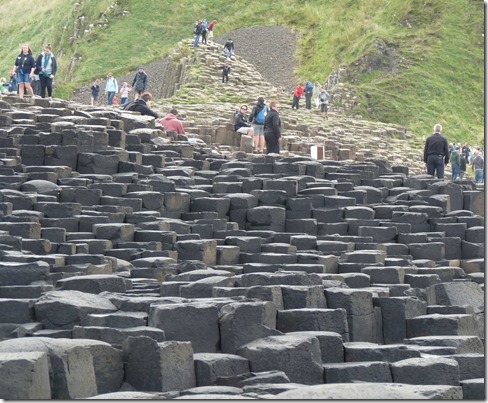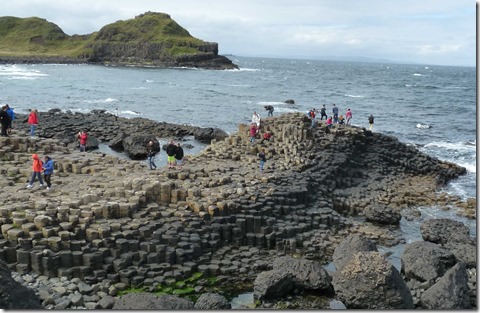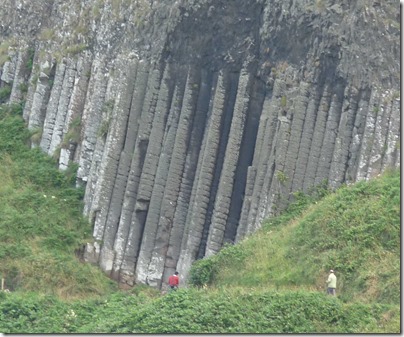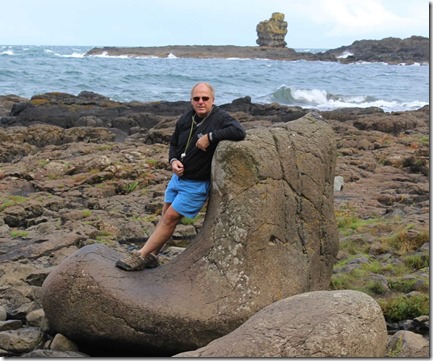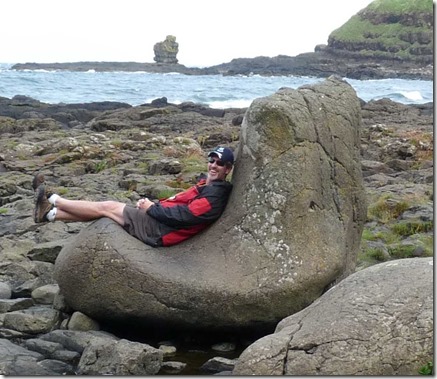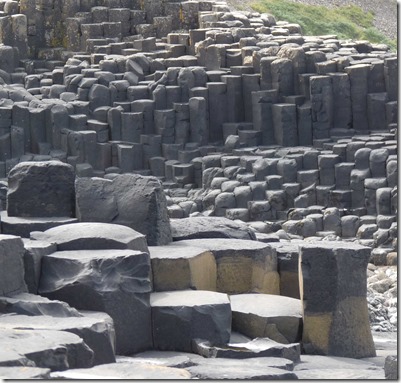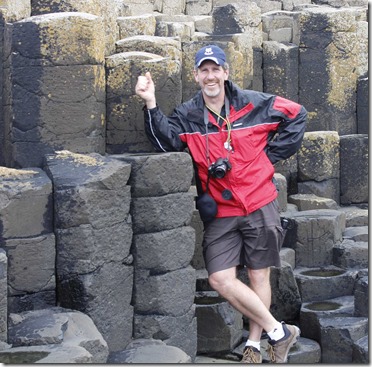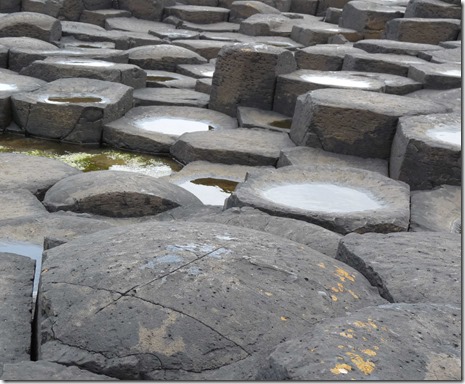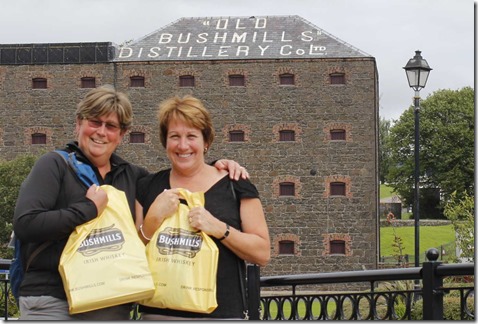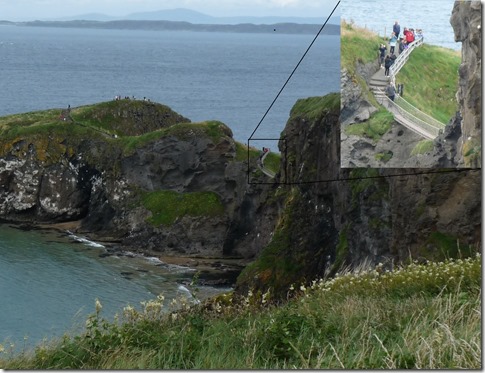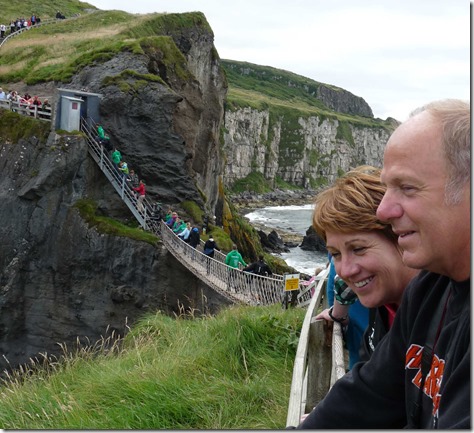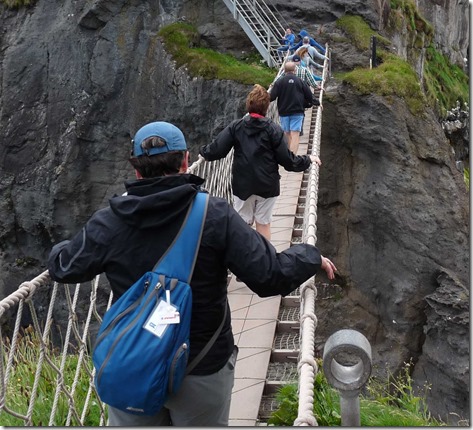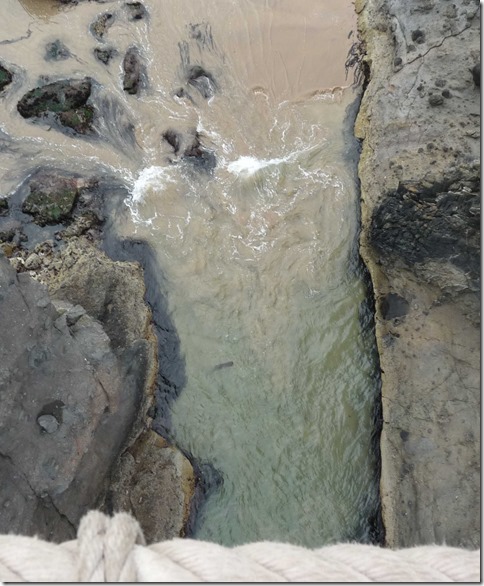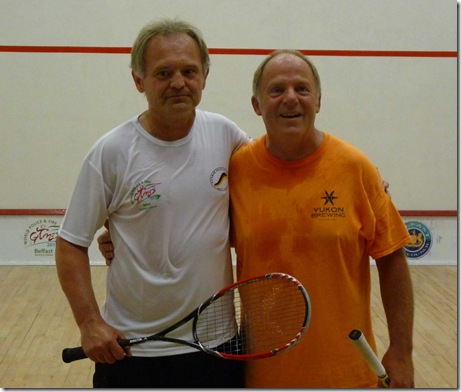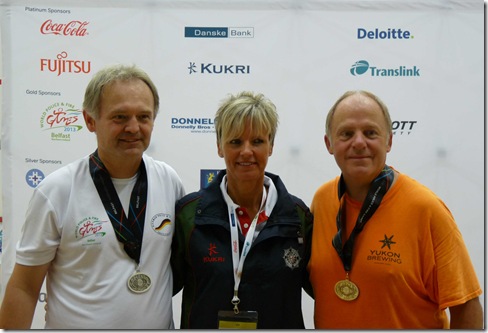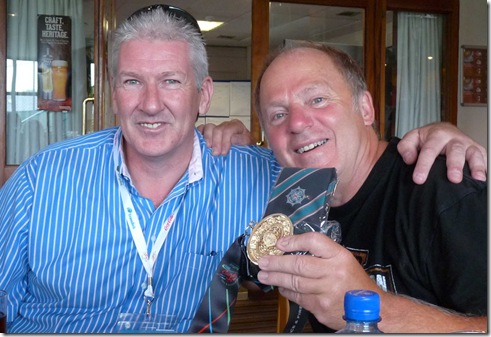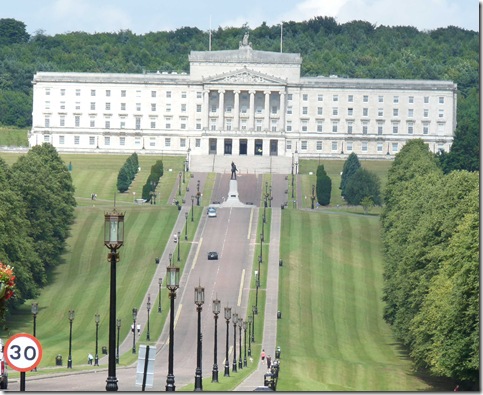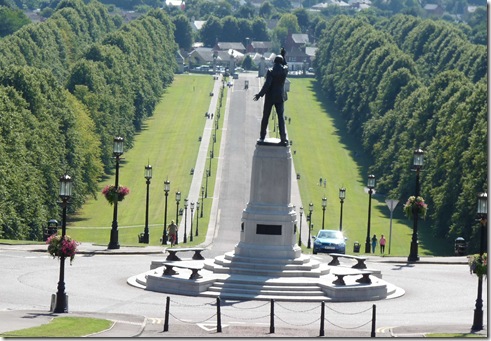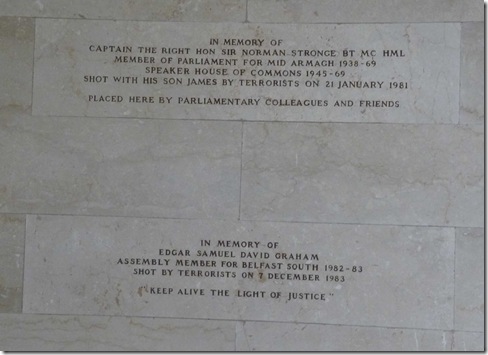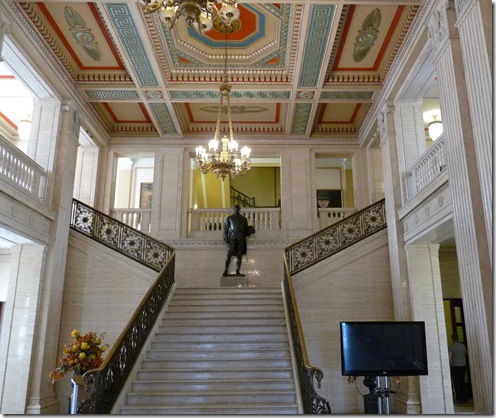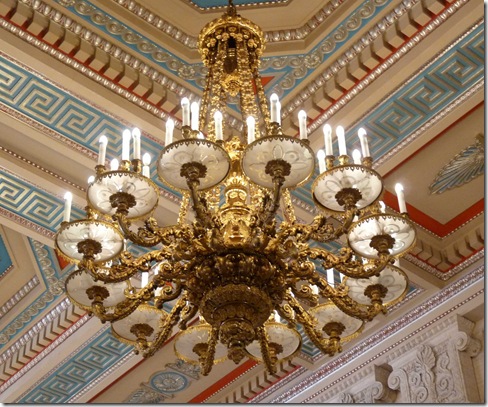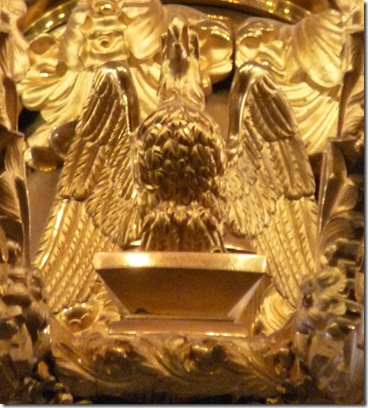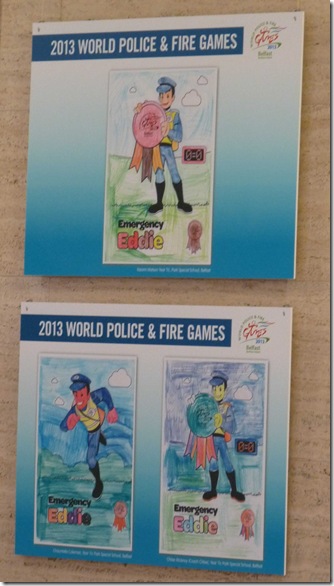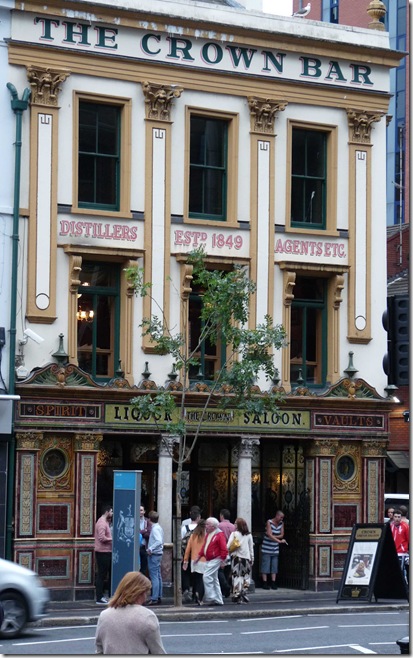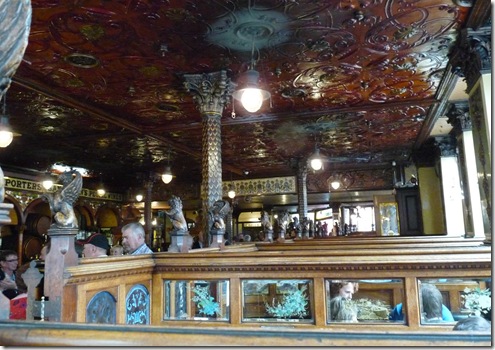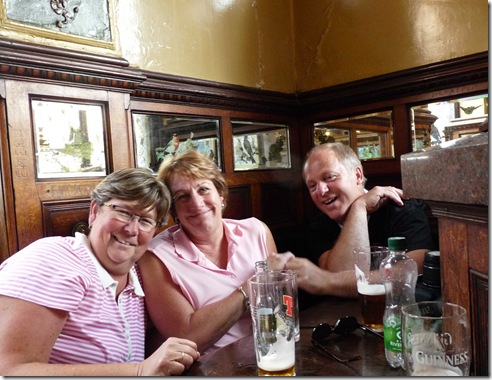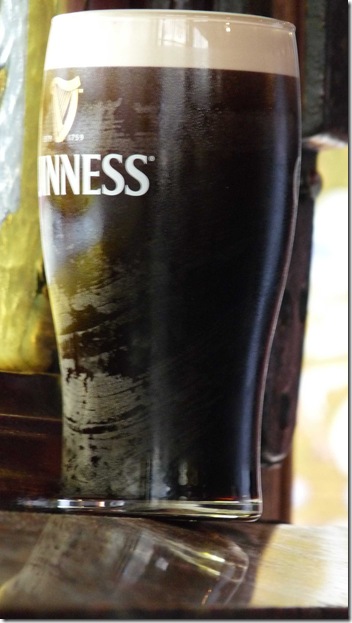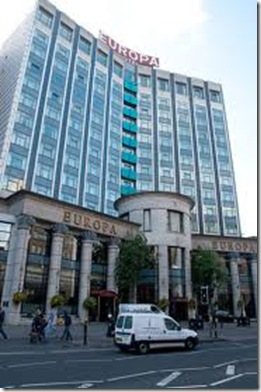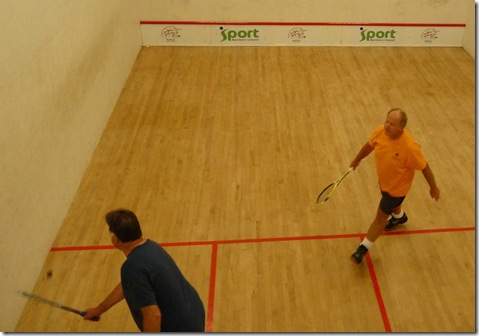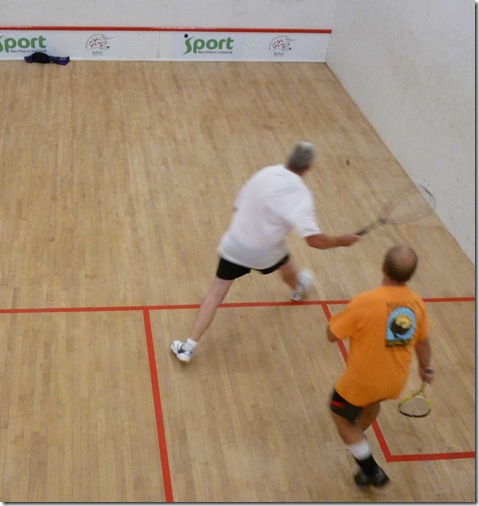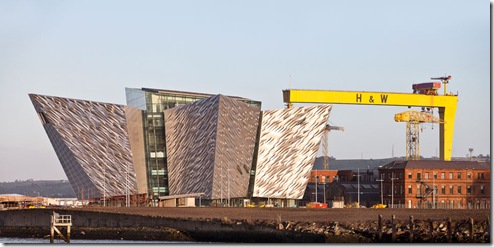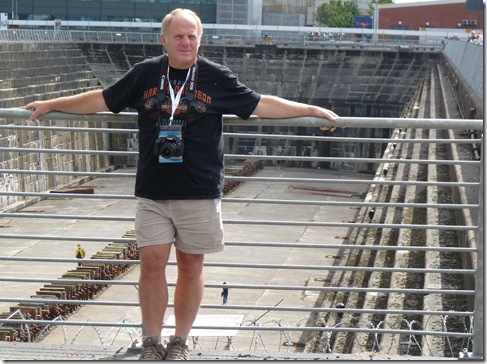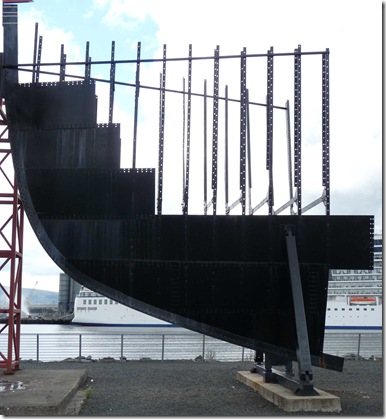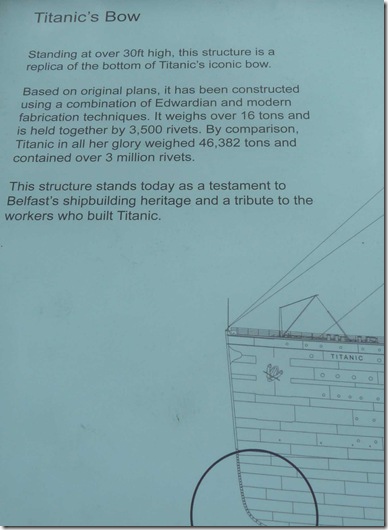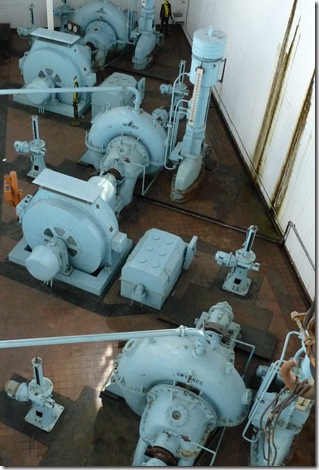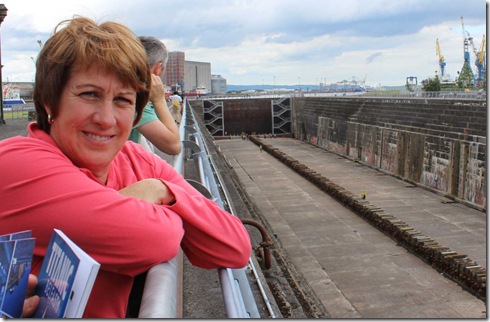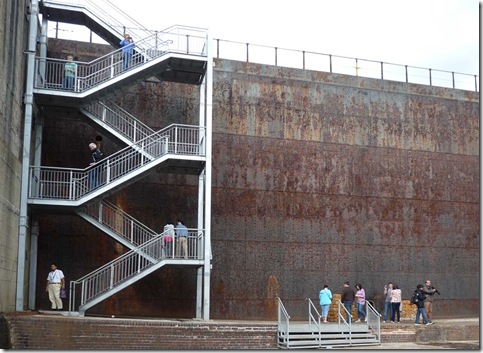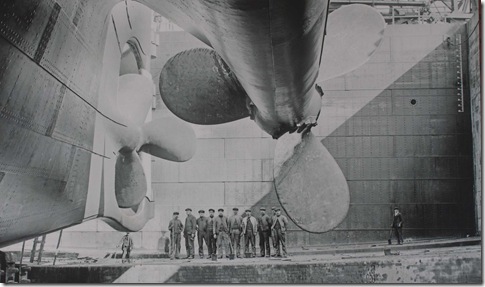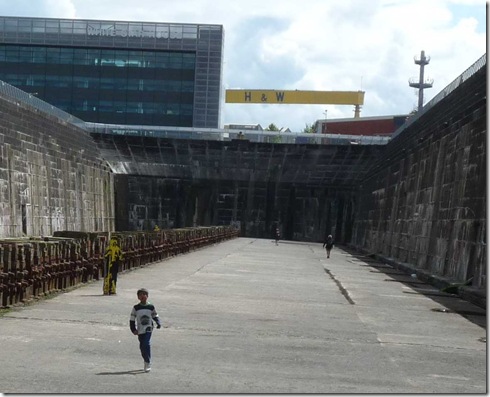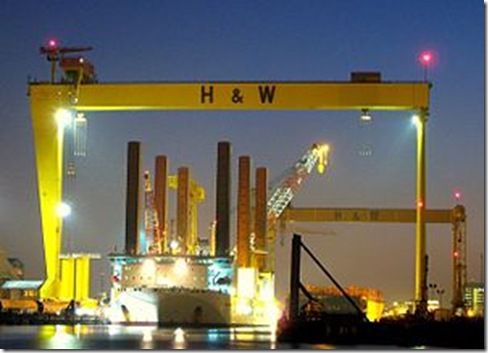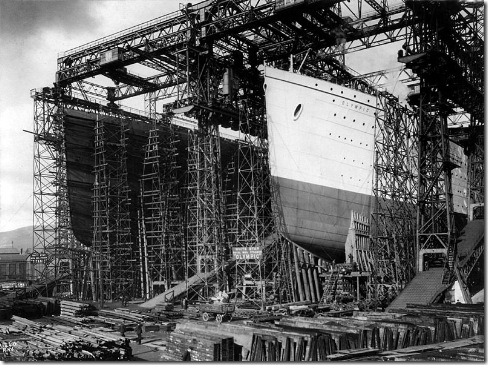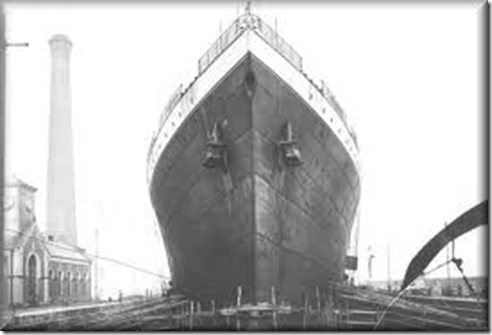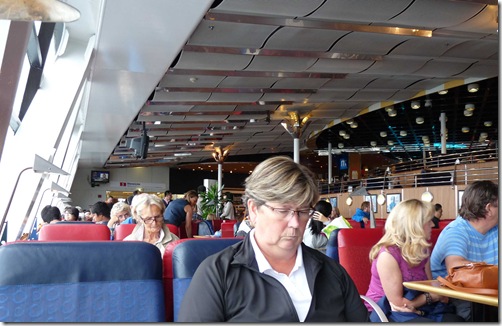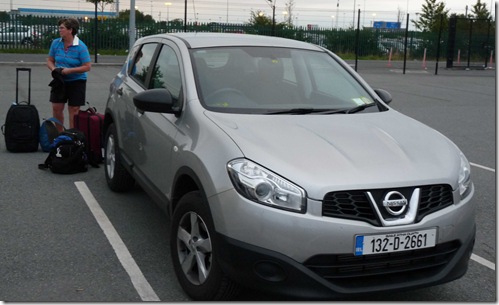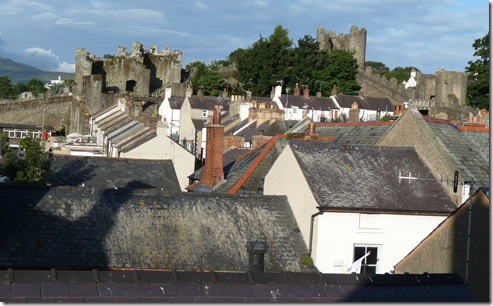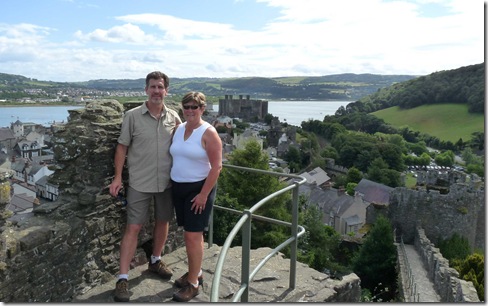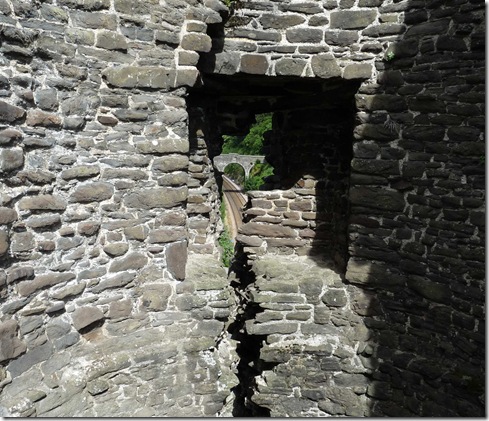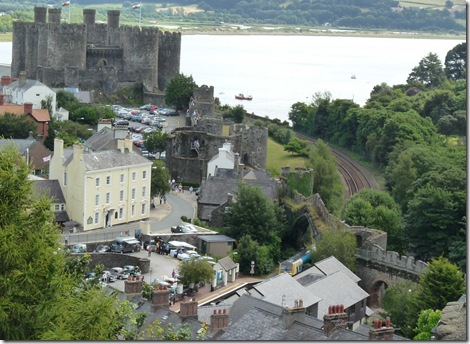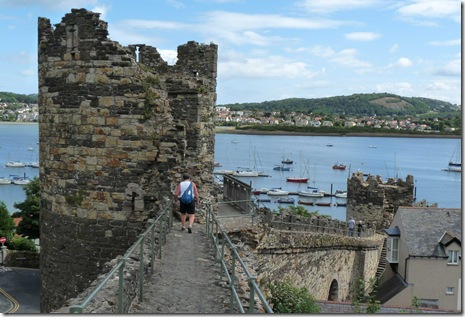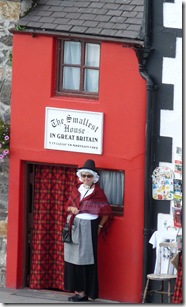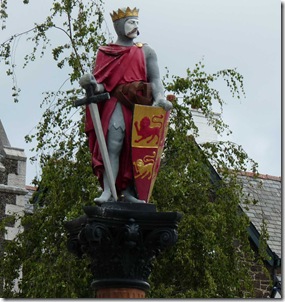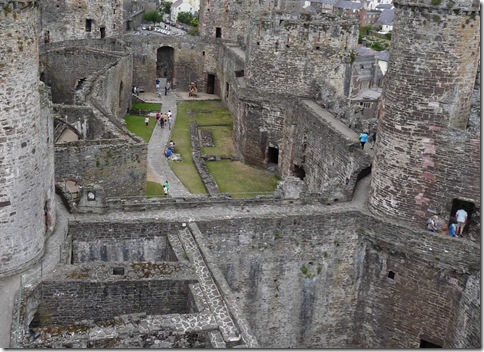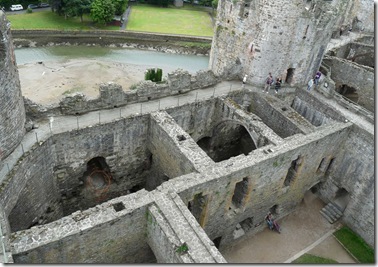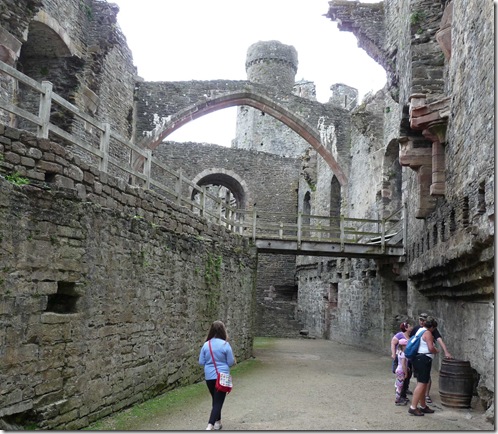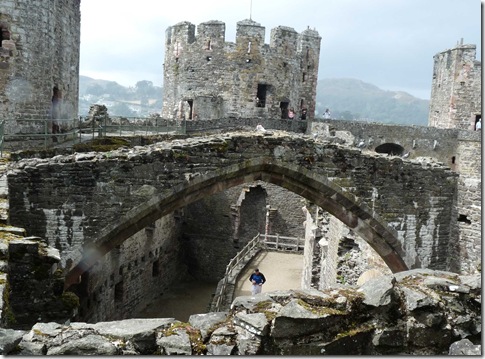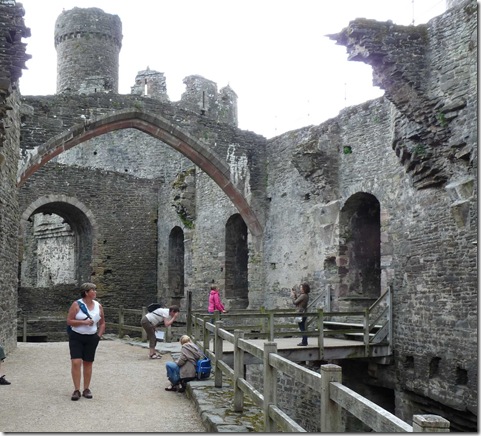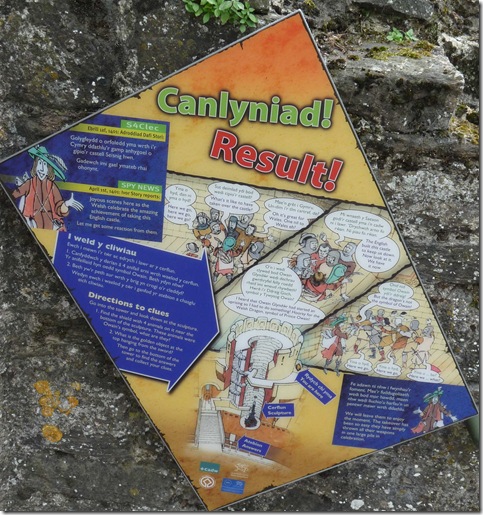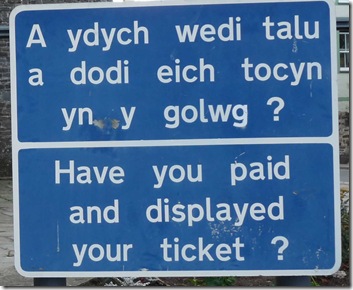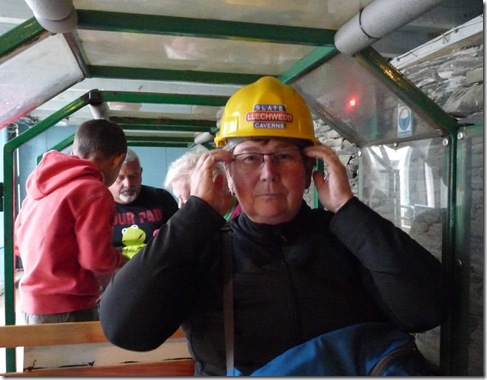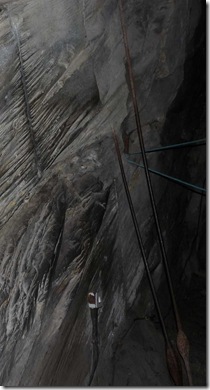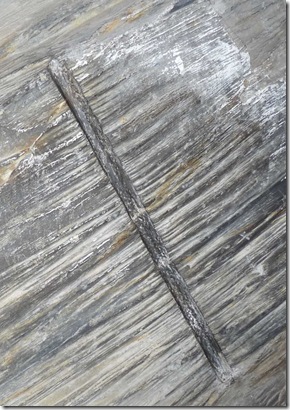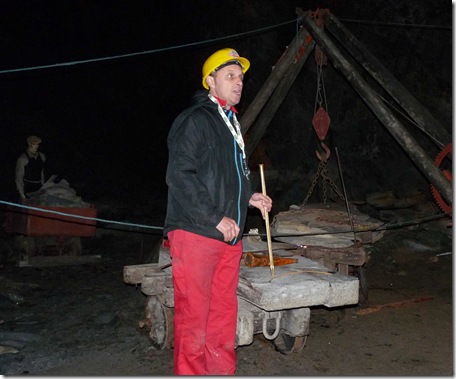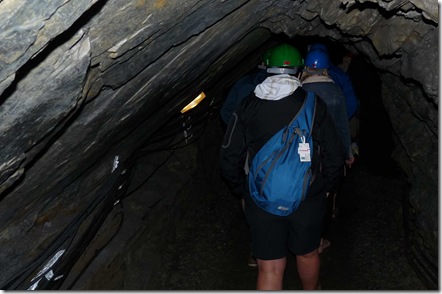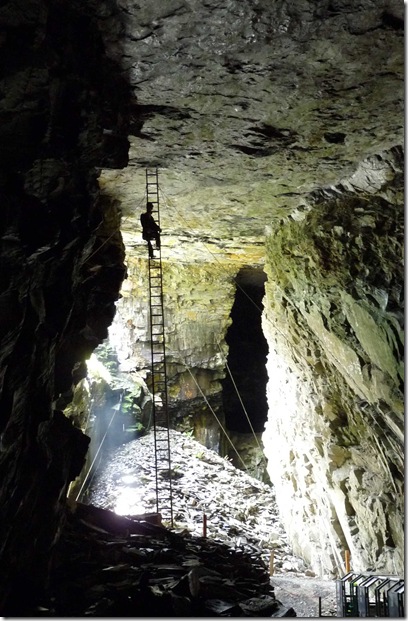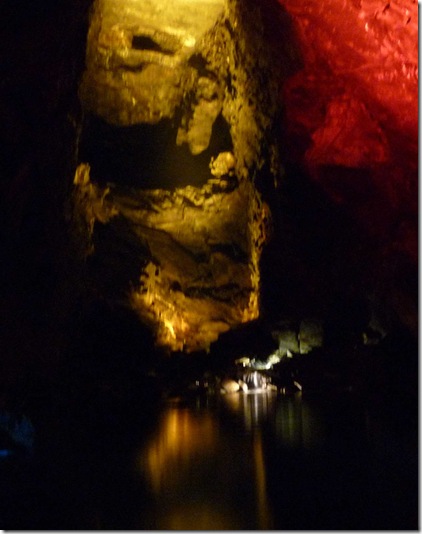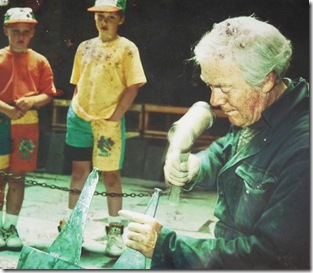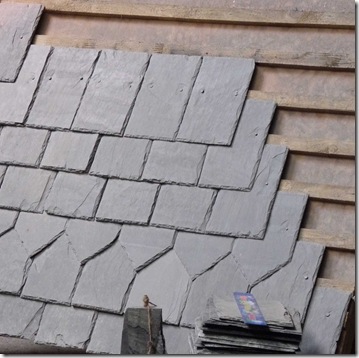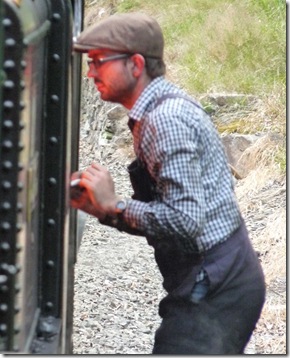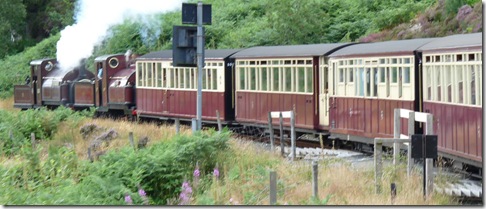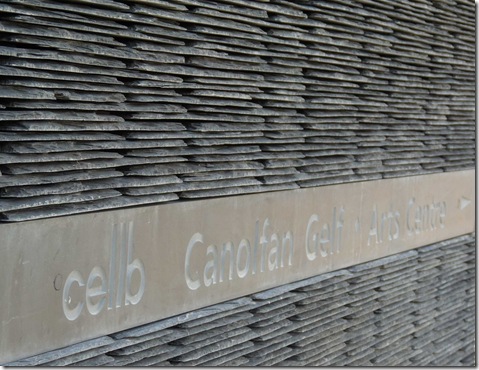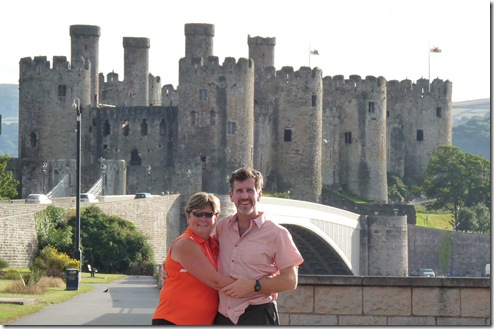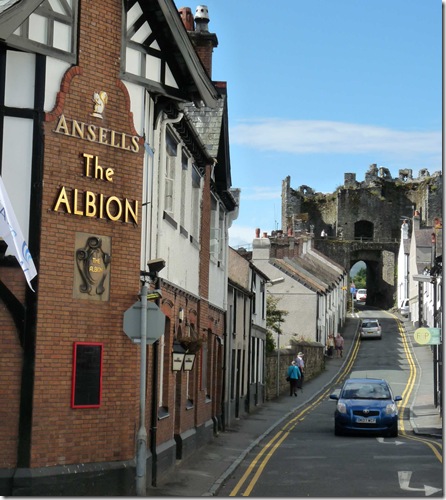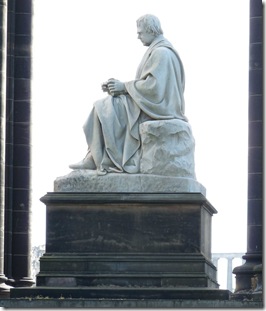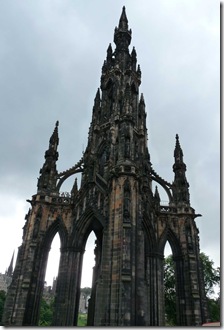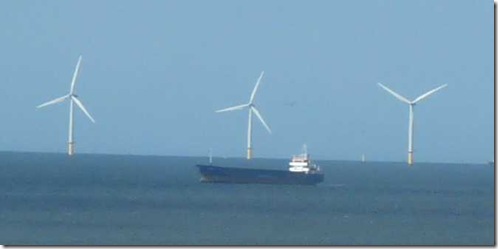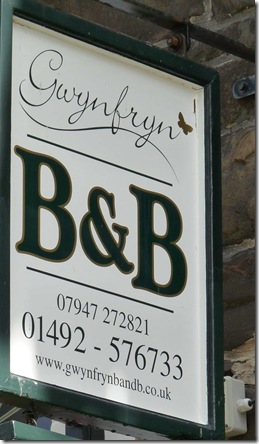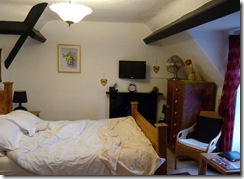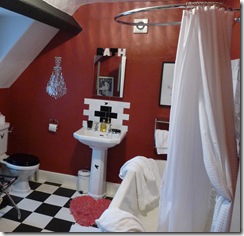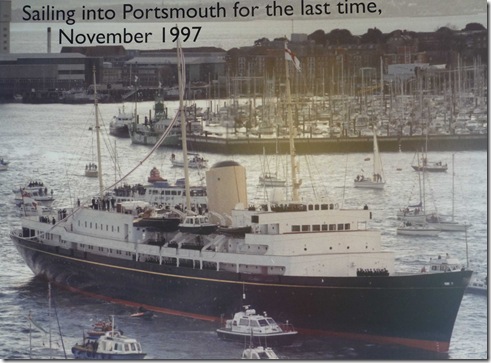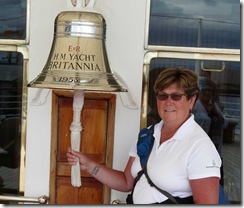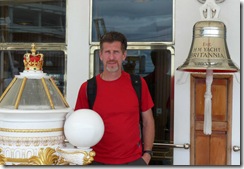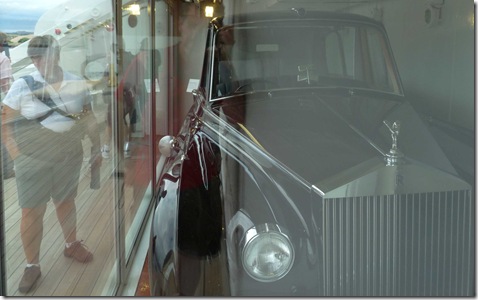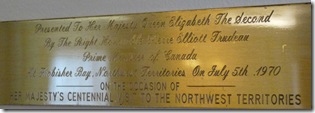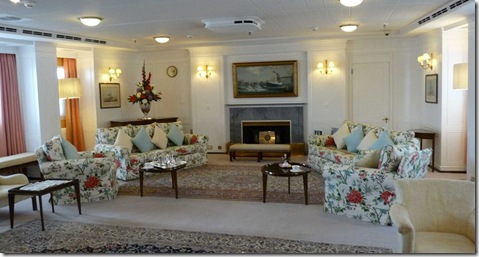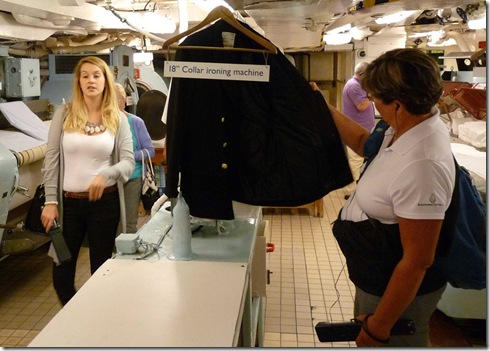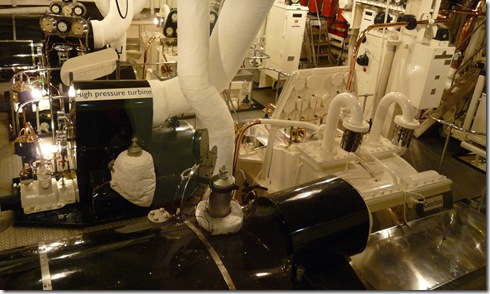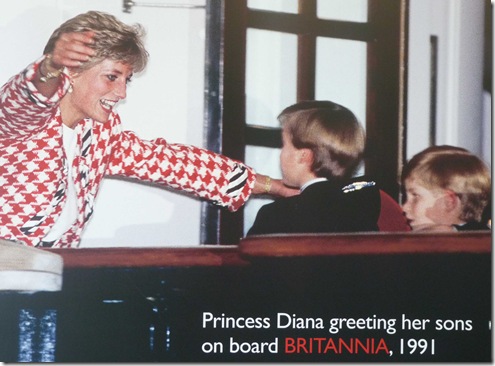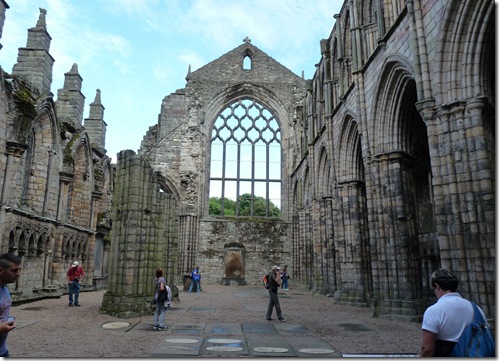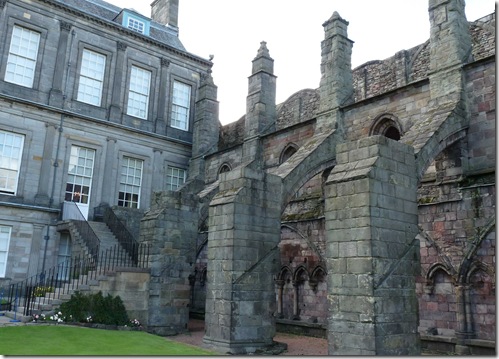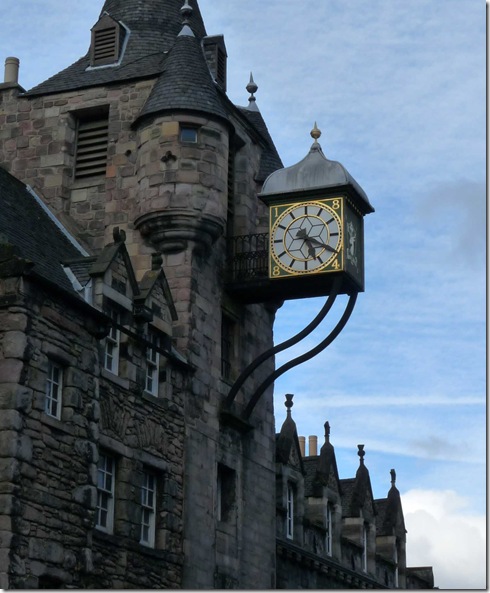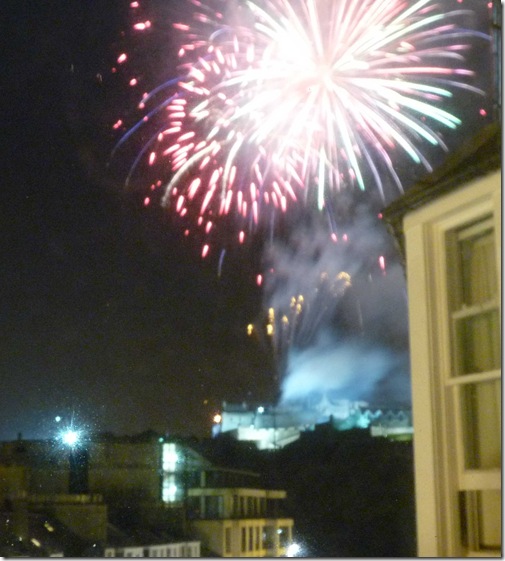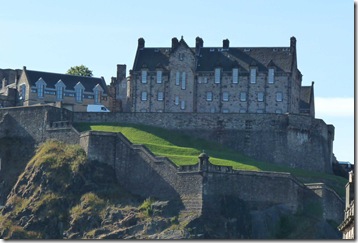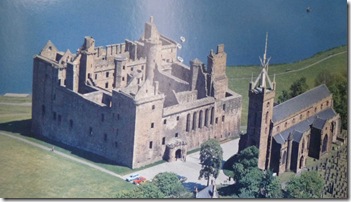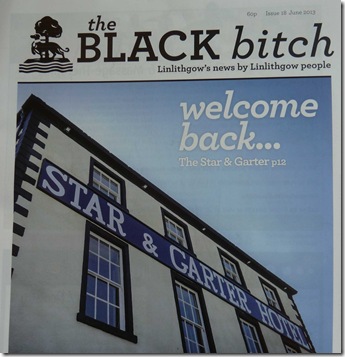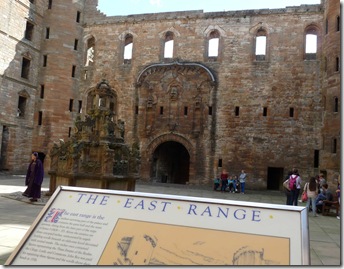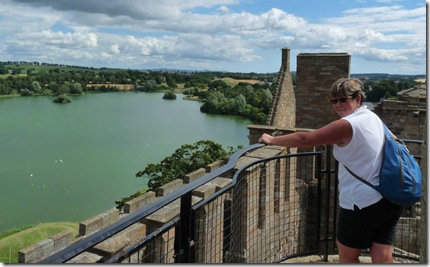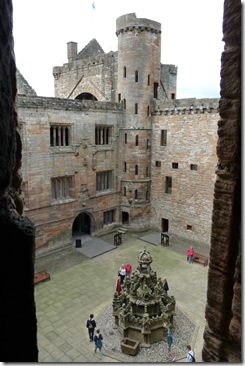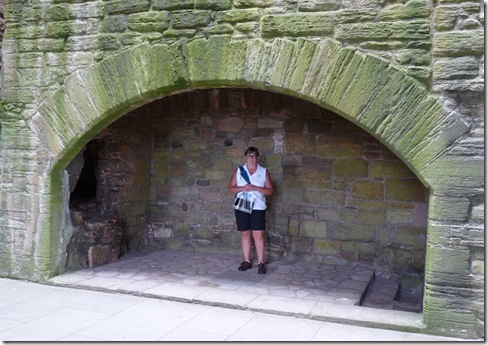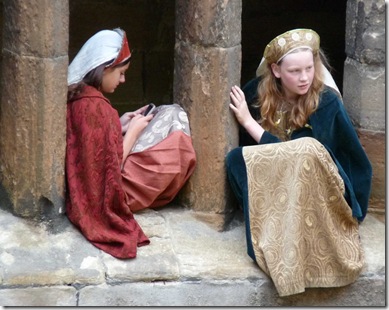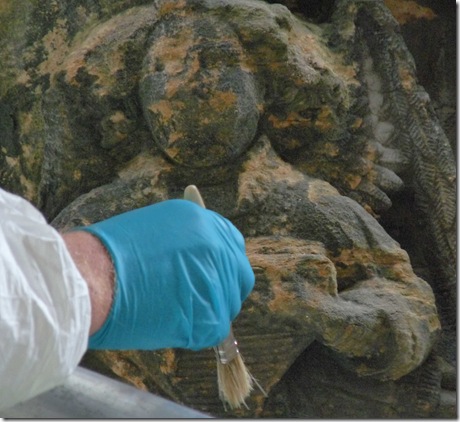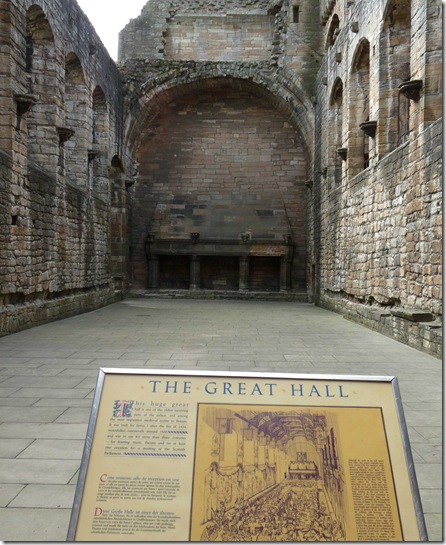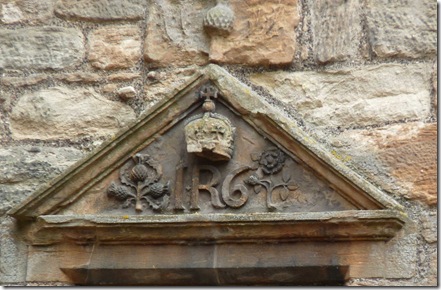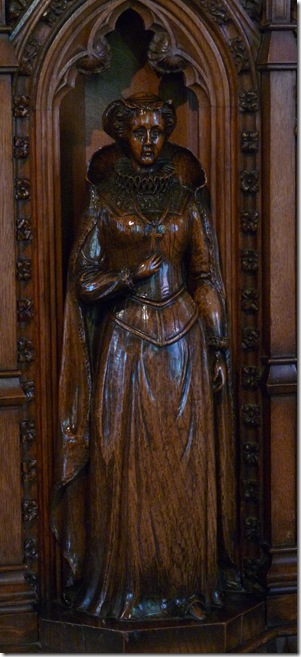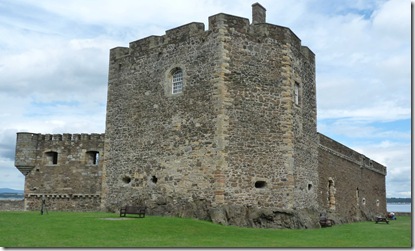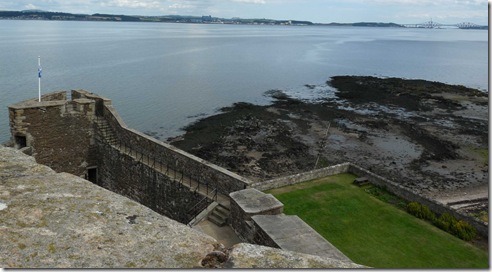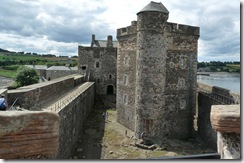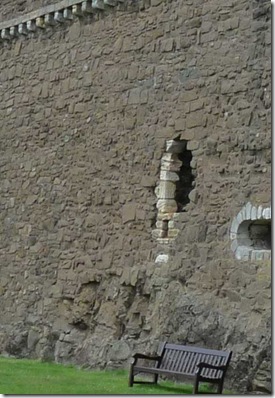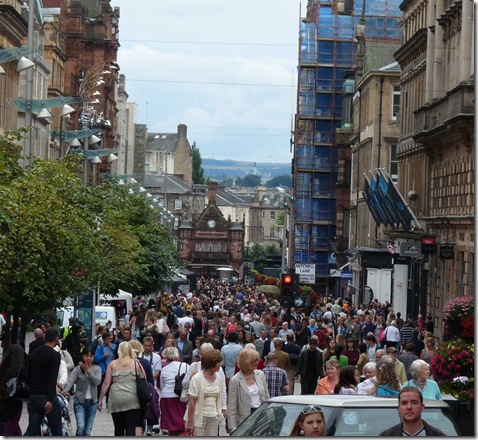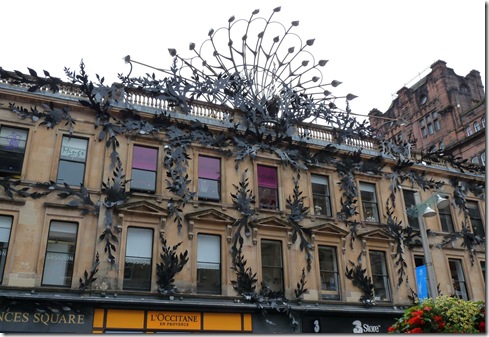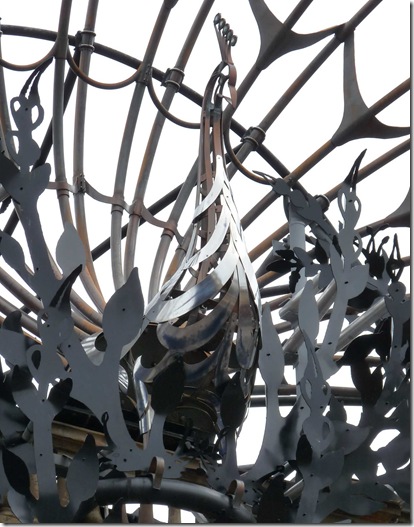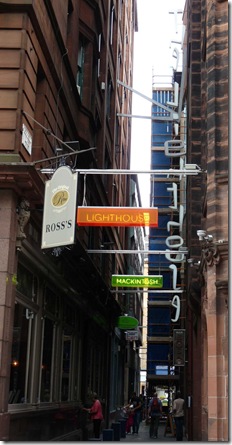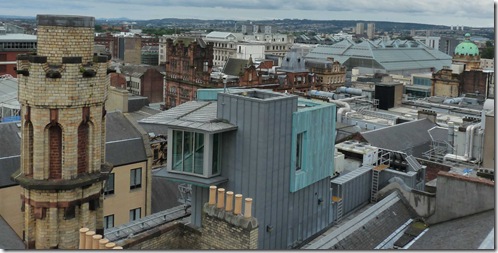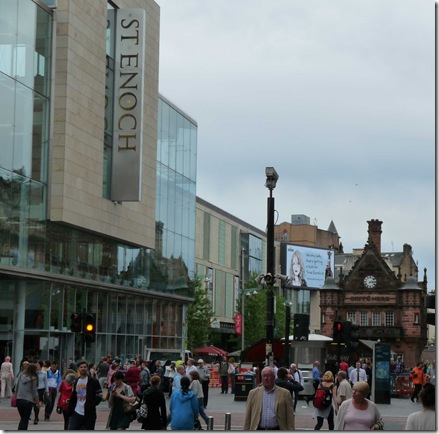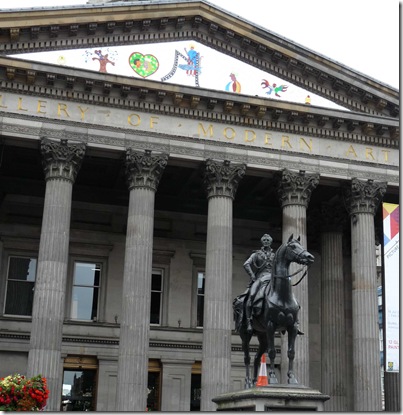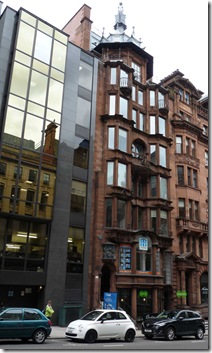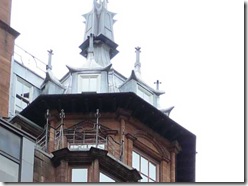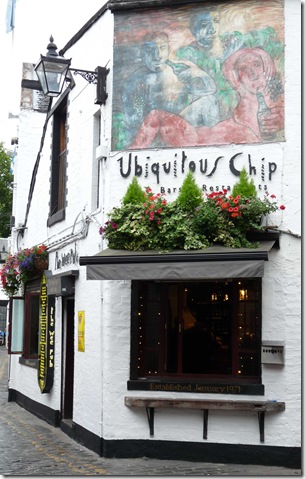Ron got off to a great start this morning at the World Police & Fire (WPF) Games and didn’t need to go to five games to win all of his matches. There were some close games, but we figure he was just trying to keep the audience engaged …… After 3 matches he qualified to play in the Final. There was some talk of playing the game in the afternoon, but his opponent from Germany was also playing badminton and had to go to a different venue for those games. So the final will be played tomorrow morning. Once again, one of the local players (well his wife that is) offered to wash Ron’s kit for him so he’d have fresh clothes to play in tomorrow. We’re pretty used to doing our own laundry in the room, but you just can’t get cotton to dry overnight.
One of the Belfast Tourist Guidebooks that was provided to the participants of the WPF Games listed a number of Tour operators but “The Black Cab Tour” (touringaroundbelfast.com) indicated that they Qualified Blue Badge Guides. Our guide in Edinburgh, Kenny, was a Blue Badge Guide so we figured that was a pretty good endorsement. We contacted the cab company and arranged to meet a cabbie in front of the steel gates of City Hall. The tour would be approximately 90 min and the cost would be £10/person. We met “Bob” (not his real name) at City Hall and we drove to the area where much of “The Troubles” began.
To help keep things straight we’ve tried to memorize:
- Unionists / Loyalists (Protestants) – identify with William of Orange (thus the colour Orange is important) and Orangemen’s Day, July 12, which also happens to be our Anniversary – fly the Union Jack to show that they want to stay attached to England as many of them were transplanted here (and came to be known as planters) from Scotland and England starting as early as 1609, living on land confiscated from the native Irish and therefore are not of Irish decent originally
- Nationalists / Republicans (Catholics) – identify with Green which has long been associated with Ireland – fly the Irish flag – would like to see Northern Ireland become a part of the rest of Ireland, an independent country from England and therefore not a part of the United Kingdom
- Ulster is another term you hear frequently. Originally it was 9 counties at the northern end of the island. The Government of Ireland Act of 1920 took 6 of the 9 counties and placed them in Northern Ireland and the remaining 3 counties were assigned to Ireland. The fact that 2 of the 6 had Catholic Nationalist majorities would suggest that not everyone was going to be happy with where the lines were drawn.
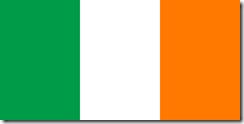
Flag of Ireland – Green for Ireland – Orange for William of Orange and the White for Peace to bring them together
What is interesting is that the tri-colour flag flown by Ireland today (and the Republicans) as their national flag was originally created as a gift by a group of French women sympathetic to the Irish cause in 1848. It was presented to Thomas Meagher, who was the son of the Newfoundland-born mayor of Waterford. The Green has been described as being representative of the Gaelic tradition of Ireland. The Orange relates to William of Orange (Protestant) King William III of England, Ireland and Scotland. The White is meant to convey the hope for Peace between the two of them.
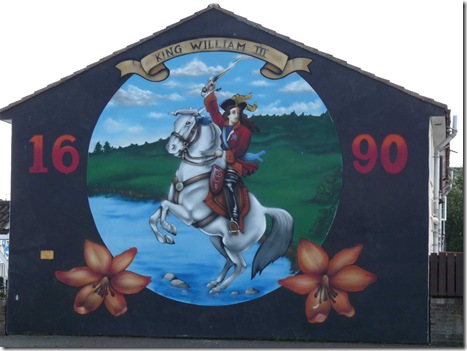
Mural for William of Orange – Protestant King of England, Scotland and Ireland
Our cabbie started in the Protestant area by turning off Shankill Road and up Shankill Parade where he parked the cab and started to tell us about “The Troubles”. We walked around a new development to reach Hopewell Crescent to get a closer look at some of the murals that have been painted on the sides of residential buildings. There are various dates suggested for the beginning of “The Troubles” as Bob refers to them. Often the deployment of British troops in August 1969 is seen as the definitive date, but there were many incidents that took place in the mid-1960’s that started “The Troubles”.
I will not pretend to have an even cursory understanding of the very complex situation that exists here. But we took the tour in hopes that we might at least gain a better understanding of the contributing factors. Some of the events took place centuries ago, in fact later, as we tour southern Ireland we hope to make it to Kinsale and learn more about the Battle of Kinsale in 1601 and how it is related to what we see today.
The domination by Protestants in Northern Ireland, backed by England, led to a revolt by the Irish nationalists who were generally of Catholic decent. As early as 1964 there was a civil rights movement seeking to end discrimination against Catholics by the Protestant, Unionist dominated government of Northern Ireland. When you listen to the issues they were fighting, it reminds you of the civil rights movement led by Martin Luther King in the USA, around the same time. They were looking for:
- an end to job discrimination – especially government jobs
- public housing allocated on the basis of need rather than religion or political views
- an end to playing with electoral boundaries to ensure the Unionists won (although I think this happens everywhere, still today)
- reform of the Royal Ulster Constabulary (RUC) which was almost 100% Protestant and accused of using excessive force against Catholics
- repeal of the Special Powers Act – that allowed the police to detain, imprison, disperse assemblies without warrant and the Catholics claim that those powers were was used almost exclusively against republicans
At one point the flying of the Irish tricolour flag was banned by legislation that prevented displaying of a symbol that was likely to inspire trouble . . . although it is said that the Union Jack was never taken down for the same reason
Many of the murals depict events in history from centuries ago, such as the William III poster for 1609 and the Red Hand of Ulster. Although the Red Hand has become synonymous with the Unionist campaign it originally represented the Irish province of Ulster. One of the stories explaining the red hand in the center of the flag comes from a mythological tale of two clans wanting to claim the land on a far shore. It was decided that the first clan leader to touch the shore would win it for his people. The two chieftans headed off in their boats with their men working their oars as hard as they could. As they neared the shore, the leader of the slower boat pulled out his sword, chopped off his hand and threw his hand onto the shore before the other chieftan could land his boat, and thus the handless chieftan won the land.

Mural depicting the legend of the Red Hand of Ulster
One of the murals on Hopewell Crescent has a hooded UFF Member centered on the wall pointing a machine gun of some sort at you. As we walked from left to right of the wall, Bob noted how the gunman appeared to be pointing at us the entire time. Optical illusion …. Yes …. but effective.
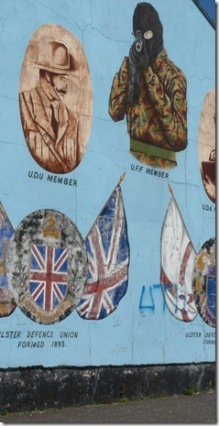
View of the masked gunman from the left
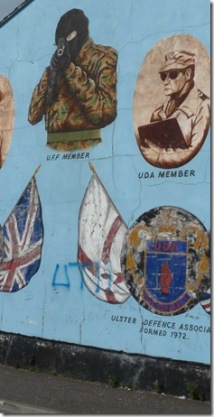
View from the right, the gun looks like it’s still pointing at you
The mural commemorating Stevie “Topgun” McKeag, Military Commander, 2nd Battalion, suggests that this is a regular army in what Bob describes as an attempt to legitimize their position. However, they were simply titles they gave themselves.
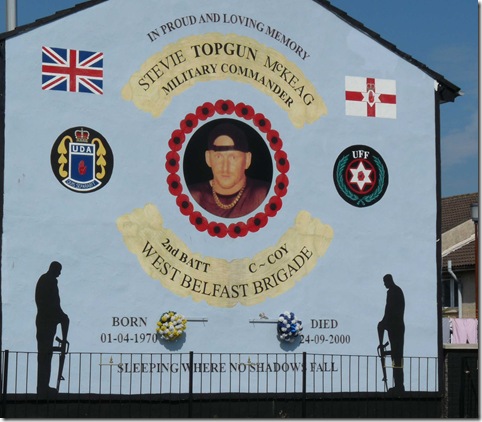
Mural commemorating Stevie “Topgun” McKeag
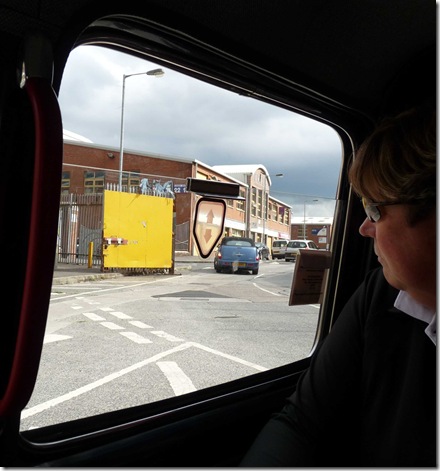
Deana looking at one of the gates in the “Peace Wall” that is still closed nightly
For every case that Bob provides for one side of the conflict he is able to give another example of the same thing occurring on the other side, so it is very difficult to determine whether Bob grew up on the Catholic or Protestant side. In one case he provided an example of one of these self appointed military men riding his motorcycle over to the Catholic side, waiting for a woman pharmacist to close up shop. At which point he shot and killed her and then jumped on his motorcycle and fled back to the Protestant area. Not exactly your typical military operation. It’s easy to see how such an event would provoke the other side to do something similar, or possibly this was in retaliation for just such an event. Unfortunately, there is no scorecard and no official record to allow someone to declare a Tie, so that everyone can stop trying to “even the score”.
We then made our way down North Howard Street to Cupar Way where we saw one of the gates keeping the Unionist and Republicans apart. Every night the gates are closed at night and then reopened again at dawn.
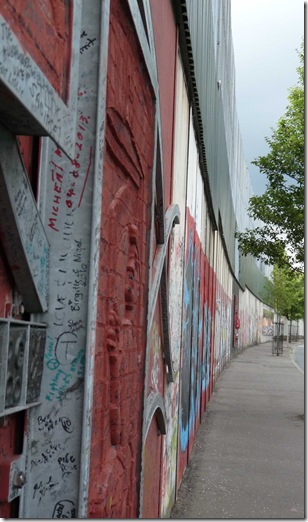
View along the Peace Wall on Cupar Way – here it extends at least 30 feet straight up
We drove along this enormous “Peace Wall” along Cupar Way and stopped at one of the areas of that has a little more than just graffiti. Bob told us of the construction of the wall as a way to keep the warring parties apart and allow the average Belfast citizen the opportunity to carry on a little more of a normal life. Three years ago both sides got together to discuss putting an end to the closing of the gates each night, but they both agreed that the animosity between some groups on each side was still too strong and it was determined that they would continue to close the gates at night, for at least another 20 years. The amazing thing is that there are 16 other “Peace Walls” like this one in various locations around Belfast.
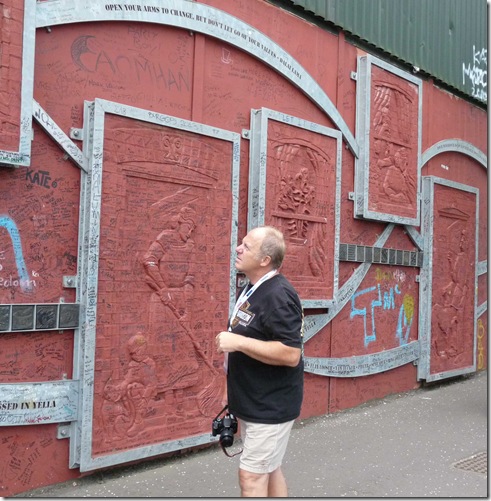
Ron examining some of the writings and graffiti along the Peace Wall
Almost exactly on the other side of the Peace Wall from where Bob stopped on the Protestant side we found a memorial on Bombay Street to those who have given their life for the Catholic side.
On the wall adjacent to the memorial is a mural remembering August 15, 1969 when homes in Dover, Percy Conway, Cupard and Bombay Streets and Clonard Gardens were attacked and burned and Gerald McAuley, 15 years of age, was shot dead. Obviously these sorts of events are not easily forgotten and the wounds they cause to the community take generations to heal.
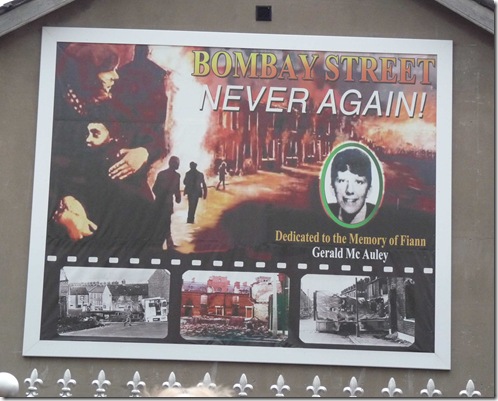
Remembering the burning of Bombay Street and others by the Unionists and the killing of Gerald McAuley
Then we look at the list of names engraved on the memorial and the dates go back well before “The Troubles” were to have started in the mid-1960’s, some as early as 1920 just before Ireland earned its independence from England. In fact, the Parliament of the United Kingdom (Britain) created the Government of Ireland Act in 1920 to establish “Home Rule” for Northern and Southern Ireland. Home Rule never took place in Southern Ireland due the Irish War of Independence that is suggested to have started on 19th of January 1919 when the Irish nationalist party Sinn Fein refused to send their elected members to the Parliament in London and instead set up their own rebel government in Dublin. It was at this time that the rebels started ambushing police barracks as they were seen as an extension of British Rule. This civil war continued for several years until 6 December 1922 when Irish Free State Act came into being. This created an independent Ireland and the next day the predominantly Protestant (non-Catholic) Parliament of Northern Ireland opted out of the Irish Free State, in effect remain as a part of the United Kingdom.
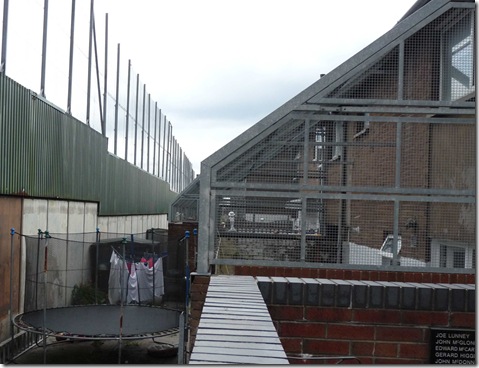
The cages over the patios that back onto the Peace Wall.
The people who’s property happened to back onto the Peace Wall have had to take steps to protect their property from things being thrown over the wall. You can see the heavy steel cage that protects their property. As we looked at the plaque on the wall of the memorial we learned that not everything can be taken at face value. If you look carefully you’ll see four names next to 9th March 1972, Gerard Crossan, John Johnston, Tony Lewis and Tom McCann. They are listed in the Roll of Honour, but Bob tells us the story that these four individuals were not shot by anyone, instead they were victims of a premature explosion of a bomb in a house. So they were likely building a bomb designed to cause harm to the Unionist side or British forces when it exploded prematurely. If you use Google to search on 9 March 1972 and one of these fellows name you’ll be hard pressed to learn about the premature explosion that Bob told us about. Most articles just state that they died for the cause, but the real story is corroborated in the CAIN.
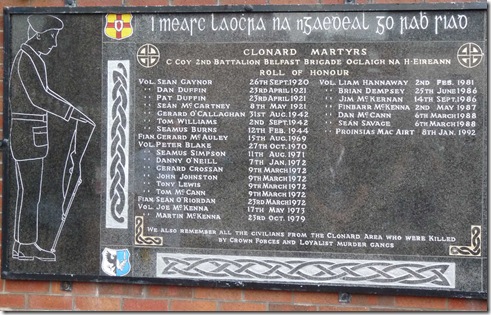
A memorial on the Republican side to remember those who died in the conflict, including the four listed on 9th March 1972 when the bomb they were building detonated prematurely
The University of Ulster has created the CAIN (Conflict Archive on the INternet) Web Service – Conflict and Politics in Northern Ireland. The website http://cain.ulst.ac.uk is designed to provide information and source material on ‘the Troubles’ and politics in Northern Ireland from 1968 to the present.
We drove a short distance from Bombay Street, down Sevastapol Street to the junction with Falls Road. Here Bob showed us the a large mural commemorating Bobby Sands. You may remember the name Bobby Sands as he gained worldwide attention when he was elected as a MP – Member of Parliament while on a hunger strike in the Maze prison in 1981. It is interesting to learn that Bobby Sands was born in Belfast to a Catholic mother and a half Catholic/half Protestant father. As Sands was not a traditional Catholic name they were able to conceal their Catholic background. Eventually neighbours found out and they were shunned by the Protestant community. They eventually granted housing in the Rathcoole development. This 30% Catholic community gave them access to Catholic schools and Bobby played for the religiously-integrated youth football team. However, after the violence that erupted in Rathcoole in 1966, Catholics were banned from the football club and Bobby and his sisters had to withstand daily pelting with rocks and bottles as they made their way through the predominantly Protestant community to the Catholic school. Oh yes, and the football club renamed itself “The KAI” for Kill All Irish. This sort of description helps us to understand why the divide between these two groups runs so deep.
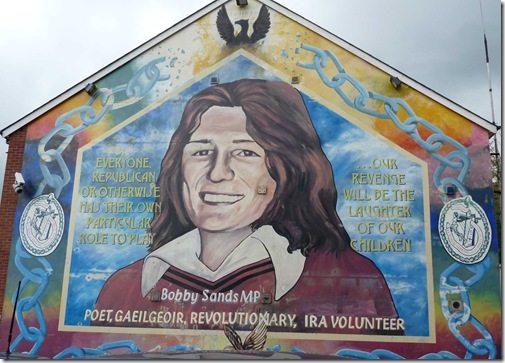
Mural commemorating Bobby Sands and the other 9 hunger strikers who died in Maze Prison, one month after Bobby was elect as an MP to the British Parliament
As members of the Provisional Irish Republican Army they believed that they should be held as Political Prisoners rather than common criminals. They were housed in H-Block at the prison which meant they were not Political prisoners. They held a number of protests, including the “Blanket Protest” in 1978, in an effort to regain Special Category Status which would free them from some of the ordinary prison rules.

This mural on Hopewell Crescent celebrated the release of prisoners from ‘ H-Block ‘ in 2000
Along Falls Road there are a number of other murals depicting other struggles, including Free Marion Price.
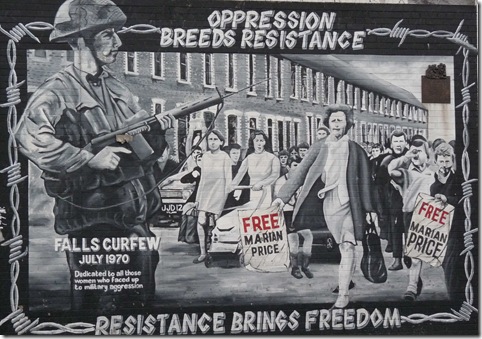
Mural on Falls Road suggesting that Marion Price didn’t deserve imprisonment for her part in 4 car bombings in London
Reading the posters you might think that she was imprisoned for standing up the the military aggression of the British Army and Northern Ireland forces. However, as you learn a little more about her part in the unit that was responsible for placing 4 car bombs in London in 1973, you begin to understand why she was incarcerated. It becomes easier to see how the people trying to keep the peace between these two groups would be drawn into the conflict. The Republicans might also suggest that the use of the British Army to maintain peace was just another example of Britain exerting its domination in Northern Ireland, just as it had been doing for centuries.
Our objective for taking the Black Cab Tour was to learn more about the issues behind “The Troubles”. One thing we have learned is that there is a lot of history involved in creating the situation we see today. One theme that Bob has frequently repeated is that the people directly involved in the conflict are a fraction of the population. However, the two sides have managed to involve the majority of the population by their terrorism. Earlier in our trip we visited the Battle of Culloden where in 1746 the Jacobites and the Government troops squared off in marshy field just east of Inverness Scotland. The battle was between combatants and the general public was not harmed or involved. Here the fight took place in the streets where people were trying to carry on their daily lives. But as Bob has given plenty of examples where people who wished to have no involvement in the conflict were assassinated on both sides of the Wall simply because they ‘appeared’ to be of a certain religious or political belief or lived in a certain area of town. Think of Bobby Sands, by all definitions a Catholic yet living in a Protestant neighbourhood. It is likely that his parents saw better opportunities for their children in Belfast if they were seen as part of the ruling Protestant group. How many more families like the Sands existed in Belfast and may even have been targeted by the IRA.
When Jeff was in Europe in 1982 he took the Tube from his cousins, Peter and Eirwen, into central London for a day of sightseeing on July 20. When he returned to the London suburbs that evening Peter informed him that while he was riding the Tube under Hyde Park a car bomb filled with shrapnel and nails was remotely detonated by the IRA as the Household Cavalry regiment passed by. Seven horses and 4 soldiers were killed and numerous soldiers, horses and tourists were injured by the shrapnel and nails, intended to wound and maim. This type of attack was an attempt by the Republicans in Northern Ireland to inflict pain on the British Army and by extension the British establishment and the general public on their home turf, in the same way that they perceived the British Army was affecting their home life. As a result, the Unionist retaliated against the IRA and the British Army and Belfast police were caught in the middle, trying to establish some semblance of peace.
After our tour with Bob we had an excellent dinner downtown at The Chubby Cherub restaurant and had a chance to talk about all we had seen and heard. Coincidentally we had also received a wonderful invitation to spend the evening with a Belfast police officer and his wife. They have a beautiful house and they immediately made us feel right at home. We really enjoyed getting to know them better and felt a real friendship develop. As we talked a bit about our afternoon with Bob we got a glimpse of another facet to the conflict that Bob had not spent to much time discussing. As the Republicans and Unionists were battling each other the Belfast Police and British Army were trying to maintain some form of law and order. They were tasked with bringing those responsible for the killings and terrorism to justice. In the eyes of the law, these people were criminals, but as we saw earlier these ‘”criminals” believed their fight to be political and therefore they deserved to be treated as Political Prisoners. A difficult distinction for the family of the woman pharmacist who was gunned down by a Unionist as she locked up her shop on the wrong side of the “Peace Wall”.
To complete the picture it is important to note that The Troubles were not limited to Belfast, Derry/Londonderry saw it’s share of strife as well. The drawing up of the boundary between Ireland and Northern Ireland had followed the River Foyle until it reached Derry where it left the river in order to include all of Londonderry in Northern Ireland. It’s easy to remember which side prefers Derry as the Republicans did not want to utter the name “London”. One of the most notable skirmishes occurred on Bloody Sunday in 1972, which started as a civil rights march.
It wasn’t until 1998 when the settlement known as the Good Friday Peace Accord or Belfast Agreement. The Agreement was made up of two elements: 1) the legal agreement between the two governments (British and Irish) signed by both; 2) a more comprehensive agreement involving the two governments and the eight political parties, including: the Alliance Party, Labour Party, Northern Ireland Women’s Coalition, Progressive Unionist Party, Sinn Fein, Social Democratic Party, Ulster Democratic Party, Ulster Unionist Party. It was this agreement that paved the way to relative peace in Northern Ireland and the eventual removal of British troops. In the two years after the Agreement was signed the paramilitary prisoners were gradually released as the groups the represented agreed to the ceasefire. On 29th of September 2000 the Maze Prison was closed.
For the policeman on the street it is not an easy job when both sides suspect that you might be trying to gather evidence that might incriminate themselves. As a result there was no safe haven for those enforcing the rule of law. One example we were given was the need to check underneath your car and seat every morning before you drive to work, just to be safe. Even if your line of work is not directly involved with either of the factions. Just by being a police officer you could be targeted by either side. In another example the IRA had tried on 3 successive days to gain entry to a policeman’s new home under the guise of being chimney sweeps. The property had been under surveillance for several weeks and the visits were timed for when the policemen would not be at home. The purpose for getting into the house might never bee known for certain, but it could have been meant as a warning that they were watching. This would be very unsettling for someone who had originally joined the police force to “help little old ladies across the street” and “apprehend bank robbers”. Instead, trying to keep the majority of the people of Belfast, Derry and other towns safe from the warring minority was putting your life and your family in jeopardy. An interesting figure is the number of police officers in the Belfast Police force. We were told there are over 7000 members and as things start to quiet down they are gradually reducing those numbers. Imagine the financial burden this places on the Belfast city council to maintain a force of this size.
Similar to our chance meeting with Margaret and Victor in Conwy, Wales, the opportunity to get to meet people who live in the local area is amazing. We learned more about life in Belfast in this one evening than we could ever have gotten from a dozen books or any tour guide.
We also learned a few local phrases the first of which is local to Belfast due to the Lagan river that flows through the center of the town. So if you want to say to someone:
“Do you think I’m stupid?” You might say: “Do you think I came up the Lagan on a bubble?”
And a more common phrase throughout the emerald isle is “What’s the craic?” pronounced “crack”. This is equivalent to What’s up? or What’s happening?
All in all a simply amazing day! Special thanks to Ron for 3 entertaining Squash games to start the day; Bob for his excellent presentation of both sides of “The Troubles”; and our wonderful hosts for welcoming us into their home and sharing their lives with us.

